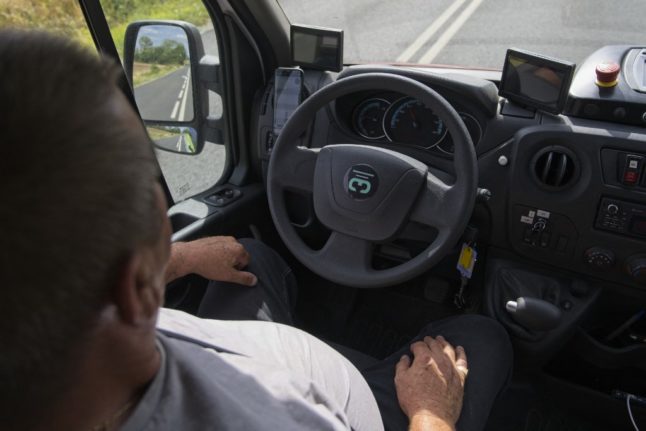On Thursday, September 1st, a new set of laws goes into place governing the introduction of “Level 3” autonomous cars French roads.
However, France is still a long way from allowing unmanned vehicles on the roads, and it is important to note that so far only one such semi-autonomous vehicle has been approved for use – the Mercedes S-Class. Several other manufacturers have also announced their plans to launch their own versions.
In France, cars are ranked on a scale of one through five based on their autonomy.
- Level 0 means that the driver controls everything (ie a standard vehicle)
- Level 1 allows for driving aids such as cruise control
- Level 2 allows for some automated tasks such as ParkAssist
Levels 0-2 are already legal on French roads.
Level 3 – which is legal from September 1st – encompasses ‘semi-autonomous vehicles’ which can operate either with a driver or automatically.
They can only be used in specific situations: on roads without pedestrians or cyclists, on roads with a lane divider (a median), and with speed limited to 60 km/h.
READ MORE: Fake laws: The real rules for driving in France you need to know
The update to the French legal framework will be important for future driverless cars, though. In case of an accident, if the autonomous driving system of the car is activated, the “driver” will not be able to be held responsible (as long as the conditions of use for the software were respected). Instead, it will be the manufacturer or the designer of the software who is held responsible.
For these Level 3 vehicles, motorists will be able to do some ‘hands-free’ driving in the above-outlined scenarios, and as a result of the updated law, it will be the manufacturer who is held responsible in case of an accident if ‘hands-free’ is activated.
This will be also be important for level 4 (fully autonomous, though with a steering wheel) and 5 (autonomous without a steering wheel or pedals) – neither of these are yet legal on French roads.
Fully driverless cars may still be in the distant future, but France has already been experimenting with some other automated types of transport.
Buses and shuttles
The Paris Metro already has driverless trains on lines 1 and 14, and a project is underway to automatise line 4.
The RATP public transport operator also began experiments with autonomous buses in September 2021, with the goal of expanding these in the years to come.
While there will still be a person sitting at the wheel, they will not be the one operating the vehicle. The steering wheel, pedals, and breaks are all operated automatically.
RATP tested the technology on line 393 in Sucy-Bonneuil, located near Paris.
RATP’s director of innovations, Côme Berbain, told Le Figaro in September 2021 that “Regular commercial operation would begin at the earliest by 2025, and the launch still depends on many parameters.”
The city has also been working with the company Alstom since 2017 to develop an autonomous tramway. Experiments have taken place on the Vitry RATP maintenance and storage site.
More recently, several cities in France have tested autonomous shuttles – or navettes.
« Dans l'#Indre, le ministre des Transports prend une dose de technologie » 🇫🇷🌳⤵️ https://t.co/7zM0M0q8oT
— Clement Beaune (@CBeaune) August 24, 2022
Transport minister Clément Beaune, on a visit to a test site in Indre, called the project “pioneering” adding: “Let’s see in a few months what this experiment gives, to draw conclusions. But if it works, I will do everything I can to ensure that the State backs it.”
Olympic transport
Paris is also seeking out smart transportation ahead of the 2024 Olympic Games. The organisation ‘Urbanloop’ was one of 21 winning projects to offer transportation ideas for the 2024 Olympic and Paralympic Games.
The ‘autonomous capsules’ have already been tested out in Nancy, as shown below.
Check it out: @UrbanLoop_Nancy is
saying they've set a new world record for energy efficient transport: .05 kwH per kilometer, maximum speed 52 km. At a test track in Nancy #France Deputy Minister of Transport was there today getting a test ridepic.twitter.com/d1bpxmlaAb— Taras Grescoe 🚇 (@grescoe) May 28, 2021
The project is described as the “deployment of fleets of autonomous capsules on rails that can carry one or two people, including people with reduced mobility or a person with a bicycle.”
These low-emissions capsules can travel at speeds of up to 60 km/h and are 100 percent electric, without batteries.
They are being hailed as a Metro alternative for small to medium sized cities. Prior to being officially put into use in Nancy in 2026, they will be tested during the 2024 Games.
The pilot project will link the entrance to the Montigny-le-Bretonneux Olympic site to a fan zone. The capsules will run on a two kilometre loop, which will serve two stations with 10 vehicles, allowing for a maximum flow of about 220 people per hour.
After the Olympics, public transportation in France is slated to become significantly more automatised, with some projections pointing to 13 percent of buses being autonomous by 2035.



 Please whitelist us to continue reading.
Please whitelist us to continue reading.
Member comments